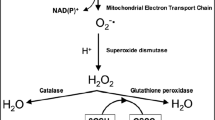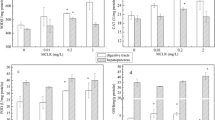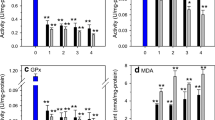Abstract
The goals of this study were to evaluate the acute and sublethal toxicity of copper (Cu2+) on the marine gastropod, Onchidium struma, and to examine the utility of enzymatic parameters as indicators of Cu2+ exposure. In a semistatic renewal test, the 96-hour median lethal concentration of Cu2+ for O. struma, 74.80 mg/L, was higher than that for other intertidal species. The activities of the antioxidative enzymes, Cu/Zn superoxide dismutase (Cu/Zn-SOD) and catalase (CAT), and those of the metabolic enzymes-acid phosphatase (ACP), alkaline phosphatase (AKP), glutamic-oxaloacetic transaminase (GOT), and glutamic-pyruvic transaminase (GPT) -in both hepatopancreas and muscle were determined after a 1-week exposure to Cu2+ (range 1.35 to 4.20 mg/L). The activities of both Cu/Zn-SOD and CAT were higher in hepatopancreas than muscle. In addition, there was a negative correlation between Cu2+ concentration and Cu/Zn-SOD activity in hepatopancreas, whereas a positive correlation was observed for CAT activity. Concentration-dependent changes in ACP and AKP activity showed a similar trend in hepatopancreas, increasing then decreasing and, finally, a slight increase. In contrast, ACP activity was positively correlated with Cu2+ across the concentration range tested. In both hepatopancreas and muscle, both GOT and GPT were activated by lower concentrations of Cu2+ and inhibited at higher concentrations.


Similar content being viewed by others
References
American Public Health Association (APHA), American Water Works Association, Water Pollution Control Federation (1985) Standard methods for the examination of water and wastewater, 16th edn. American Public Health Association, Washington, DC
Arun S, Subramanian P (1998) Antioxidant enzymes in freshwater prawn Macrobrachium malcolmsonii during embryonic and larval development. Comp Biochem Physiol B 121:273–277
Agency for Toxic Substances and Disease Registry (ATSDR) (2005) CERCLA priority list of hazardous substances. US Department of Health and Human Services, Public Health Agency, Atlanta, Georgia, USA. Available at: http://www.atsdr.cdc.gov/cercla/.
Aurélie D, Carole C, Marie-Cécile J, Marc B, Paule V (1997) Antioxidant enzymes, glutathione and lipid peroxidation as relevant biomarkers of experimental or field exposure in the gills and the digestive gland of the freshwater bivalve Unio tumidus. Aquat Toxicol 39:93–110
Ay Ö, Kalay M, Tamer L, Canli M (1999) Copper and lead accumulation in tissues of a freshwater fish Tilapia zillii and its effects in the branchial Na, K-ATPase activity. Bull Environ Contain Toxicol 62:160–168
Bambang Y, Thuet P, Charmantier-Daures M, Trilles J-P, Charmantier G (1995) Effect of copper on survival and osmoregulation of various developmental stages of the shrimp Penaeus japonicus Bate (Crustacea, Decapod). Aquat Toxicol 33:125–139
Beauchamp C, Fridovich I (1971) Superoxide dismutase: Improved assays and an assay applicable to acrylamide gels. Anal Biochem 44:276–287
Blackmore G (1999) Temporal and spatial biomonitoring of heavy metals in Hong Kong coastal waters using Tetraclita squamosa. Environ Pollut 106:273–283
Bocher P, Caurant F, Miramand P, Cherel Y, Bustamante P (2003) Influence of the diet on the bioaccumulation of heavy metals in zooplankton-eating petrels at Kerguelen archipelago, Southern Indian Ocean. Polar Biol 26:759–767
Brouwer M, Syring R, Brouwer TH (2002) Role of a copper-specific metallothionein of the blue crab, Callinectes sapidus, in copper metabolism associated with degradation and synthesis of hemocyanin. J Inorg Biochem 88:228–239
Bryan GW, Langston WJ, Hummerstone LG (1980) The use of biological indicators of heavy metal contamination in estuarie. Occasional Publication No. 1. Marine Biological Association, UK
Bryan GW, Langston WJ, Hummerstone LG, Burt GR (1985) A guide to the assessment of heavy metal contamination in estuaries using biological indicators. Occasional Publication No. 4. Marine Biological Association, UK
Chan HM (1988) Accumulation and tolerance to cadmium, copper, lead and zinc by the green mussel Perna viridis. Mar Ecol Prog Ser 48:295–303
Chen JC, Lin CH (2001) Toxicity of copper sulfate for survival, growth, molting and feeding of juveniles of the tiger shrimp, Penaeus monodon. Aquaculture 192:55–65
Chew SF, Ho SY, Ip YK (1999) Free amino acids and osmoregulation in the intertidal pulmonate Onchidium tumidium. Mar Biol 134:735–741
Dang ZC, Lock RAC, Flik G, Wendelaar Bonga SE (2000) Na+/K+-ATPase immunoreactivity in branchial chloride cells of Oreochromis mossambicus exposed to copper. J Exp Biol 203:379–387
Deshpande UD, Nagabhushanam R (1983) Seasonal changes in the biochemical composition of the chiton Chiton iatricus (Polyplacophora: Mollusca) and the marine pulmonate Onchidium verruculatum (Gastropoda: Mollusca) in relation to their reproductive cycles. Mar Biol 72:227–234
Deshpande UD, Nagabhushanam R, Hanumante MM (1980) Preliminary evidence for the hormonal control of urea concentration in the marine pulmonate, Onchidium verruculatum. Hydrobiologia 75:45–47
Dewez D, Geoffroy L, Vernet G, Popovic R (2005) Determination of photosynthetic and enzymatic biomarkers sensitivity used to evaluate toxic effects of copper and fludioxonil in alga Scenedesmus obliquus. Aquat Toxicol 74:150–159
Falahi-Ardakani A (1984) Contamination of environment with heavy metals emitted from automotives. Ecotoxicol Environ Saf 8:152–161
Gwozdzinski K (1995) Structural changes in erythrocyte components induced by copper and mercury. Radiat Phys Chem 45:877–882
Hanumante MM, Deshpande UD (1980) Regulation of ammonia (NH3-N) metabolism in the marine pulmonate, Onchidium verruculatum. I. Effects of a neuroendocrine centre on tissue ammonia levels. Hydrobiologia 68:265–268
Hanumante MM, Deshpande UD, Nagabhushanam R (1979) Hormonal control of blood chloride in the marine pulmonate, Onchidium verruculatum. Hydrobiologia 67:125–127
Jiang TJ, Niu T (2006) Effects of heavy metals on superoxide dismutase (SOD) of Crassostrea rivularis. Ecol Environ 15:289–294; in Chinese
King L (1965) The hydrolases—acid and alkaline phosphatases. In: Van D (ed) Practical clinical enzymology. Nostrand, London, UK
Lehtonen KK, LeiniÖ S (2003) Effects of exposure to copper and malathion on metallothionein levels and acetylcholinesterase activity of the mussel Mytilus edulis and the clam Macoma balthica from the Northern Baltic Sea. Bull Environ Contam Toxicol 71:489–496
Li L, Jiao XZ (1980) A method for protein determination using the protein stain Coomassie brilliant blue G250. Plant Physiol Commun 6:52–55
Lim CB, Low WP, Chew SF, Ip YK (1996) Survival of the intertidal pulmonate Onchidium tumidium during short-term and long-term anoxic stress. Mar Biol 125:707–713
Lovley DR, Coates JD (1997) Bioremediation of metal contamination. Curr Opin Biotechnol 8:285–289
Lowry MB, Duchemin AM, Robinson JM, Anderson CL (1998) Functional separation of pseudopod extension and particle internalization during Fcγ gamma receptor-mediated phagocytosis. J Exp Med 187:161–176
Matz JM, Blake MJ, Saari JT, Bode AM (1994) Dietary copper deficiency reduces the heat shock protein expression in cardiovascular tissues. FASEB J 8:97–102
Mazon AF, Cerqueira CCC, Fernandes MN (2002) Gill cellular changes induced by copper exposure in the South American tropical freshwater fish, Prochilodus scrofa. Environ Res 88:52–63
Méndez L, Racotta IS, Acosta B, Rodríguez-Jaramillo C (2001) Mineral level in tissue during ovarian development of white shrimp Penaeus vannamei (Decapoda: Penaeidae). Mar Biol 138:687–692
Ministry of Agriculture and State Environmental Protection Administration (2006) Report on the state of the fishery eco-environment in China for the year 2005. Beijing, ROC; in Chinese
Ministry of Environment Protection (1989) Water quality standard for fisheries in china, GB11607–1989. Beijing, ROC; in Chinese
Nordberg GF, Fowler BA, Nordberg M, Friberg L (2007) Handbook on the toxicology of metals, 3rd edn. Elsevier (formerly Academic Press), New York, NY
Office of Pesticide Programs (2000) Pesticide ecotoxicity database (formerly: environmental effects database). Environmental Fate and Effects Division, United States Environmental Protection Agency, Washington, DC
Palmer Locarini SJ, Presley BJ (1996) Mercury concentrations in benthic organisms from a contaminated estuary. Mar Environ Res 41:225–239
Press OW, DeSantes K, Anderson SK, Geissler F (1990) Inhibition of catabolism of radiolabeled antibodies by tumor cells using lysosomotropic amines and arboxylic lonophores1. Cancer Res 50:1243–1250
Rand GM (1995) Fundamentals of aquatic toxicology, 2nd ed. Taylor and Francis, London, UK
Reitman S, Frankel S (1957) A colorimetric method for the determination of serum glutamic oxalacetic and glutamic pyruvic transaminases. Am J Clin Pathol 28:56–63
Riba I, Conradi M, Forja JM, DelValls TA (2004) Sediment quality in the Guadalquivir estuary: lethal effects associated with the Aznalcóllar mining spill. Mar Pollut Bull 48(1–2):144–152
Salánki J, V-Balogh K (1989) Physiological background for using freshwater mussels in monitoring copper and lead pollution. Hydrobiologia 188/189(1):445–454
Shen HD, Chen HC, Chen XL, Sun HW, Hua XM, Xiao HJ (2004) Preliminary studies on the absorption rates and the feeding effects of different diets on sea-slug Onchidium sp. J Shanghai Fish Univ 13:293–297; in Chinese
Shen SQ, Zhang Y, Xiang JJ, Xiong CL (2007) Protective effect of curcumin against liver warm ischemia/reperfusion injury in rat model is associated with regulation of heat shock protein and antioxidant enzymes. World J Gastroenterol 13:1953–1961
Slavica SB, Sladjan ZP, Tijana BK, Andraš ŠŠ, Vojislav MP, Zorica SS (2008) Antioxidant defence enzyme activities in hepatopancreas, gills and muscle of Spiny cheek crayfish (Orconectes limosus) from the River Danube. Comp Biochem Physiol C 147:122–128
Taylor MP, Kesterton RGH (2002) Heavy metal contamination of an arid river environment: Gruben River, Namibia. Geomorphology 42(3–4):311–327
Tessier A, Tumer DR (1995) Metal speciation and bioavailability in aquatic systems. Wiley, Chichester, UK
Viarengo A, Nott JA (1993) Mechanisms of heavy metal cation homeostasis in marine invertebrates. Comp Biochem Physiol C Comp Pharmacol Toxicol 104:355–372
Vitale AM, Monserrat JM, Casthilo P, Rodriguez EM (1999) Inhibitory effects of cadmium on carbonic anhydrase activity and ionic regulation of the estuarine crab, Chasmagnathus granulata (Decapoda, Grapsidae). Comp Biochem Physiol C 122:121–129
Wan GF, Zhao YF, Lv JC, Liu CF (2007) Effect of Cu2+ on CAT, SOD, GSH-PX of Paralichthys olivaceus. J Huazhong Agric Univ 26:836–838; in Chinese
Wendelaar Bonga SE (1997) The stress response in fish. Physiol Rev 77:591–625
Wendelaar Bonga SE, Lock RAC (1992) Toxicants and osmoregulation in fish. Neth J Zool 42(2–3):478–493
Winner RW, Farrel MP (1976) Acute and chronic toxicity of copper to four species of Daphnia. J Fish Res Board Can 33:1685–1691
Zhou YX, Zhang ZS (1989) Experimental method of hydrobiology toxicity. Agriculture Press, Beijing, ROC; in Chinese
Acknowledgments
This project was supported by the Shanghai Key Project for Developing Agriculture by Science and Technology (Grant No. 2005D4-3) and the National Science Foundation of China (Grant No. 30671607).
Author information
Authors and Affiliations
Corresponding author
Rights and permissions
About this article
Cite this article
Li, Xb., Hou, Xl., Mao, Q. et al. Toxic Effects of Copper on Antioxidative and Metabolic Enzymes of the Marine Gastropod, Onchidium struma . Arch Environ Contam Toxicol 56, 776–784 (2009). https://doi.org/10.1007/s00244-009-9290-2
Received:
Accepted:
Published:
Issue Date:
DOI: https://doi.org/10.1007/s00244-009-9290-2




